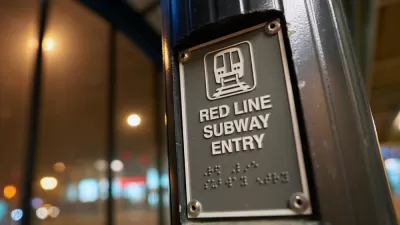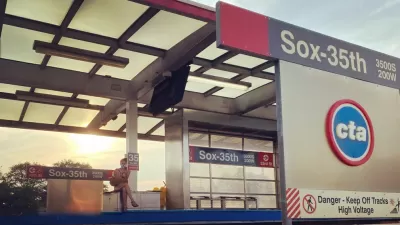The Red Line Extension on Chicago’s South Side could be a game changer, if the city can figure out the local funding.

The Federal Transit Administration (FTA) and the Chicago Transit Authority (CTA) published the Final Environmental Impact Statement for the Red Line Extension (RLE) in August, marking a key benchmark in a project in the works since 2006, with high hopes for delivering economic benefit to parts of Chicago long underserved by public transit.
The 5.6-mile extension will extend the Red Line’s southern terminus from 95th Street to 130th Street, with tracks running at both ground level and on elevated structures.
“The project is one of three major components in CTA’s larger Red Ahead Program, which is designed to maintain, modernize and expand the Red Line – the city’s most traveled rail line,” according to an article by Mischa Wanek-Libman for Mass Transit. In addition to providing details of the extension, Wanek-Libma also neatly lays out the economic development case for the project, noting that the CTA estimates the RLE project would deliver a 46 percent increase in newly accessible jobs within an hour commute of the RLE Project Area.
Jared Brey picked up on the news of the EIS and covers the project from multiple different angles for Governing, including a focus on the controversy surrounding the use of a new tax increment financing (TIF) scheme to raise about $950 million—the local share of the project.
“TIF is used by local officials across the U.S., but nowhere more than in Chicago,” explains Brey. The RLE TIF is different than the city’s typical TIF, however. “For one thing, the school district would still collect its full share of the property tax in the district. It’s also unique in that it would generate the tax increment in an area with more economic activity closer to the urban core and distribute its benefits to a public project in the South Side.” Hence the unofficial title, “equity TIF.” As documented by Brey, the idea is controversial.
Brey also recounts some of the decade-plus of planning that preceded the EIS, and provides a thorough discussion of the economic benefit the extension is expected to deliver to Chicago’s South Side—not to mention the entire city.
FULL STORY: Final EIS/ROD issued for CTA’s Red Line Extension project

Study: Maui’s Plan to Convert Vacation Rentals to Long-Term Housing Could Cause Nearly $1 Billion Economic Loss
The plan would reduce visitor accommodation by 25,% resulting in 1,900 jobs lost.

North Texas Transit Leaders Tout Benefits of TOD for Growing Region
At a summit focused on transit-oriented development, policymakers discussed how North Texas’ expanded light rail system can serve as a tool for economic growth.

Using Old Oil and Gas Wells for Green Energy Storage
Penn State researchers have found that repurposing abandoned oil and gas wells for geothermal-assisted compressed-air energy storage can boost efficiency, reduce environmental risks, and support clean energy and job transitions.

Private Donations Propel Early Restoration of Palisades Playground
Los Angeles has secured over $1.3 million in private funding to restore the Pacific Palisades playground months ahead of schedule, creating a modern, accessible space that supports community healing after recent wildfires.

From Blight to Benefit: Early Results From California’s Equitable Cleanup Program
The Equitable Community Revitalization Grant (ECRG) program is reshaping brownfield redevelopment by prioritizing projects in low-income and environmental justice communities, emphasizing equity, transparency, and community benefits.

Planting Relief: Tackling Las Vegas Heat One Tree at a Time
Nevada Plants, a Las Vegas-based nonprofit, is combating the city’s extreme urban heat by giving away trees to residents in underserved neighborhoods, promoting shade, sustainability, and community health.
Urban Design for Planners 1: Software Tools
This six-course series explores essential urban design concepts using open source software and equips planners with the tools they need to participate fully in the urban design process.
Planning for Universal Design
Learn the tools for implementing Universal Design in planning regulations.
Ascent Environmental
Borough of Carlisle
Institute for Housing and Urban Development Studies (IHS)
City of Grandview
Harvard GSD Executive Education
Toledo-Lucas County Plan Commissions
Salt Lake City
NYU Wagner Graduate School of Public Service





























